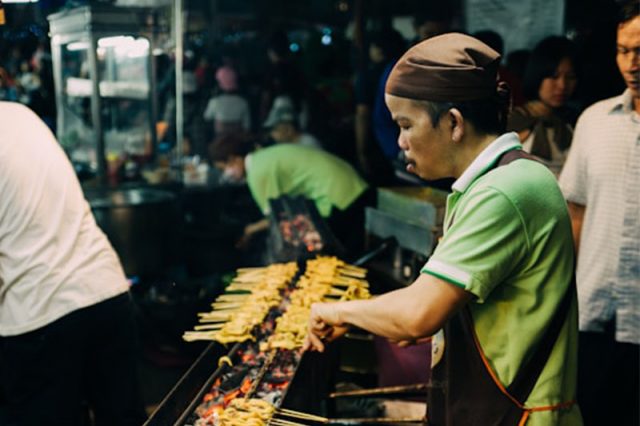Imagine working during a heat wave, standing over a boiling hot stove in a busy restaurant with no air conditioning, limited ventilation and no access to a break until you’ve worked five consecutive hours.
To cope, you drape a damp hand towel over your shoulders and stand in the walk-in freezer for a brief moment to cool down. While beads of sweat drip down your forehead, your employer pulls you aside and says he cannot risk having customers see you sweat. It appears unhygienic. This experience is typical for many food service workers during extreme heat.
From fields to fryers, a warming planet is intensifying occupational health and safety threats to low-wage workers across the food chain. Of particular note are migrant agricultural workers and restaurant workers in Canada who share many similar conditions.
Workers in both farms and restaurants face daunting barriers to unionization, experience hazards like sexual harassment and fear employer retaliation and job loss. Extreme heat, flooding and wildfires are exacerbating this precarity, and labor laws are failing to protect workers.
In a warming world it is essential that labor protections and climate justice go hand in hand.
On the front lines of extreme heat
Alvita is a 37-year-old mother from Jamaica who has worked in Canada’s Seasonal Agricultural Worker Program (SAWP) since 2014. She described what it was like to live in an overcrowded bunkhouse in British Columbia during the deadly 2021 Pacific Northwest heat dome:
I’m telling you, if it is summer, you are going to die because you can’t sleep in it… all of that heat piercing in from the sun… It is so hot. Like naturally, just walking in the heat makes you feel dizzy. It’s like you’re in a furnace. And there is no fan, there is nothing. No windows you can open up, no nothing.
Alvita’s experience with grossly inadequate cooling and ventilation is a common story we heard in our interviews in Ontario and B.C. In both provinces the employers of migrant agricultural workers provided substandard housing which often undermined their physical and mental health.
Workers felt pressured not to complain because their work permits were precarious, and they feared repatriation.
Globally, heat stress and dehydration among agricultural workers has been associated with kidney disease. When farm workers have access to air conditioning, their sleep quality improves, with an array of potential benefits for their health.
Indoor workers also face hazards during extreme heat.
During the heat dome, one-third of calls to WorkSafeBC were related to high temperatures in restaurants.
A report, prepared by the Worker Solidarity Network, surveyed and interviewed restaurant workers across B.C. and found that 77 per cent of restaurant workers reported adverse physical health effects, and a lack of protective measures, during high temperatures. Some described these conditions as “abusive,” “dehumanizing” and “absolute hell.”
It is also worth remembering that these conditions are occurring in a restaurant industry which is notoriously gendered, racialized and difficult to unionize.
One restaurant cook from B.C.’s interior reflected:
I have this very specific story of this one day where it was just so hot — I couldn’t rationalize why I was still at work…so much was going around like the forest fires and the heat itself… While I was working, all I could think of was climbing over the counter and pushing my way out of the restaurant and getting the hell out of there. But I couldn’t because it’s like, how am I going to pay rent?
This sentiment captures the reality of precarious work: having to choose between persevering through poor working conditions or risking a paycheck. These stories point to other labour issues like the complexity of refusing unsafe work and the balancing of multiple jobs to make ends meet amid rising prices and unaffordable housing.
Protections for workers on a warming planet
When it comes to updating labour laws to protect workers from climate change, governments in Canada are woefully behind the curve.
Provinces like B.C. should look to places like California for examples of effective regulations to protect both indoor and outdoor workers. Washington State has also recently implemented a permanent heat rule for outdoor workers requiring bosses to, amongst other things, offer shade and cool water when the mercury rises above 27 C.
In Canada, we recommend three policy interventions that would go a long way toward protecting workers in the food industry and beyond:
1. Maximum temperature policy:
Despite the devastating lessons learned from the heat dome, there is no maximum temperature policy in B.C.
Current heat exposure regulations note that workers should be protected from thermal stress in environments where their core body temperature may exceed 38 C. This measure has not been updated since 2005 and does not proactively limit workers’ exposure to heat-related illness. We encourage the government to update this regulation or establish a distinct and comprehensive “too hot to work” policy that does not merely use core body temperature as a marker to refuse unsafe work.
2. Better access to union protections:
Unions give workers a democratic voice in the workplace, such as collectively bargaining for wage and job protection during environmental disasters. Unions may also play an important social movement role in pushing governments to hold fossil fuel companies accountable for climate pollution.
Agricultural workers in provinces like Ontario should have the option of joining a union, and Canadian provinces should consider broader-based and sectoral bargaining. This could make unions more accessible to precarious workers in private sector jobs with high turnover like fast food.
3. Stronger enforcement of health and safety regulations:
Even the best labour protections for workers are useless unless they are enforced in practice.
Advocates note that when workers in B.C. file formal complaints about unfair working standards, they can face extremely long wait times — from six months to three years in some instances.
Workers in low-wage sectors need random, proactive health and safety inspections. They also need better oversight on the enforcement of personal protective equipment, heat stress assessments and worker training on exposure plans. The federal government should also co-ordinate strong, enforceable national housing standards for migrant agricultural workers that include thermal comfort.
An ongoing effort
This May Day, everyone across Canada should take a moment to reflect on past labour injustices and the growing challenges facing exploited workers. History has shown that workers can have a seat at the table and while the conditions today may be different, the solutions are nothing new.
Individual Canadians, and unions, across the country must maintain constant pressure on governments and industry to give teeth to climate change-related occupational safety standards so that everyone — and especially working people — can be healthy, safe and work with dignity on a planet changing beyond all recognition.![]()
Jen Kostuchuk, PhD Student, Sociology, University of Victoria and Anelyse Weiler, Assistant Professor, Sociology, University of Victoria. This article is republished from The Conversation under a Creative Commons license. Read the origial article.










